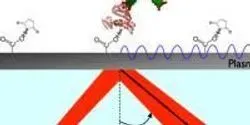FTIR / NIR

A newly developed spectroscopy method is helping to clarify the poorly understood molecular process by which an anti-HIV drug induces lethal mutations in the virus’ genetic material. The findings from the University of Chicago and the Massachusetts Institute of Technology could bolster efforts to develop the next generation of anti-viral treatments.

A research team led by North Carolina State University has identified and synthesized a material that can be used to create efficient plasmonic devices that respond to light in the mid-infrared (IR) range. This is the first time anyone has demonstrated a material that performs efficiently in response to this light range, and it has applications in fields ranging from high-speed computers, to solar energy to biomedical devices.

Rigaku Raman Technologies, a leading pioneer of handheld and portable Raman spectrometers, will be showcasing its new generation handheld Raman analyzer for raw material identification (RMID) in booth 1C82 at CPhI Worldwide 2014 (7-9th October 2014. Paris Nord Villepinte, France). Progeny™ (http://www.rigakuprogeny.com) delivers improved performance, ease of use and confidence to ensure the industry’s most accurate and comprehensive range of material identification in a handheld form.

Rigaku's Handheld Raman Analyzer Wins IBO Award for Portable Analytical Instrument Industrial Design
Rigaku Raman Technologies, a leading pioneer of handheld and portable Raman spectrometers, is delighted to announce that its handheld Raman analyzer, Progeny™ (www.rigakuprogeny.com) has received the Bronze Award for the Portable Analytical Instrument Industrial Design category in the 2014 Instrument Business Outlook (IBO) Design Awards.

This application note from Shimadzu explores use of UV-Vis and FTIR in monitoring and characterizing gold nanoparticles.

Tulane University chemistry professor Igor Rubtsov and a team of graduate students can lay claim to inventing an important new scientific instrument — the world’s first fully automated dual-frequency, two-dimensional infrared spectrometer.


Fourier transform infrared (FTIR) spectroscopy, a subset of infrared (IR) spectroscopy, uses a mathematical algorithm, Fourier transform, to translate raw infrared data into a spectrum. FTIR is useful for the analysis of organic and inorganic compounds that exhibit changes in polarity as a result of the vibration, spinning, or perturbation of molecular bonds. FTIR methods are common in such industries as foods, materials, chemicals, pharmaceuticals, forensics, and others. Advantages of FTIR over conventional IR are higher resolution, better signal-to-noise, easier analysis of very small samples and poorly-absorbing species, and much more rapid analysis.










